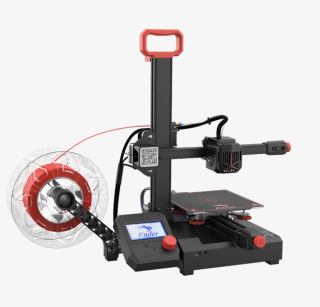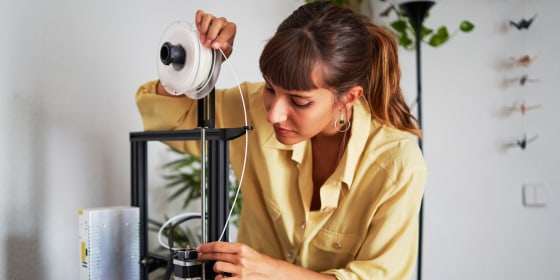
The best 3D printers, according to experts
Our 3D printing experts share their favorites and how to get started.




For folks who can dedicate some of their space to 3D printing, Bertacchi recommends the Elegoo Neptune 3 Pro. It comes mostly assembled, and includes a wide variety of great features like a large max volume, auto bed leveling, a flexible plate, direct drive and more, according to Bertacchi and the brand.
The Neptune 3 Pro is a newer product in high demand. If it’s out of stock, we also recommend the previous Neptune 2S. While it doesn’t have auto bed leveling, it is still an easy-to-use printer with a large build volume.
Modeling: FDM | Max build volume: 8.85 x 8.85 x 11.02 inch | Bed leveling method: Auto | Supported filaments: PLA, ABS, TPU, PETG, wood, marble, other | Weight: 17.85 lbs | Assembly Required: Yes
While Hailey did not recommend his personal favorites, he did point us to popular, top-rated models like the Mini+ from Prusa. “Prusa is a reputable company that provides quality printers that are known to print well,” said Hailey. “They are recognized for their awesome customer support and being an established brand.”
This printer is small but mighty, with useful features like auto bed leveling and a filament runout sensor, all in a lightweight package.
Modeling: FDM | Max build volume: 7.08 x 7.08 x 7.08 inch | Bed leveling method: Auto | Supported filaments: PLA, PETG, ASA, ABS, and other | Weight: 9.9 lbs | Assembly Required: Yes
For extra “hand-holding,” Bertacchi recommended the Wuxn WXR, a premium option from a newer, Colorado-based brand. The Wuxn WXR is pricier than the other options on our list, but it has many features that make printing easy: high-quality parts, auto bed leveling, a flexible build plate, and extra “wizards” that offer step-by-step walkthroughs of different processes. It is also the only printer on our list that ships fully assembled.
Modeling: FDM | Max build volume: 9.84 x 8.26 x 9.84 inch | Bed leveling method: Auto | Supported filaments: PLA, PET, ASA, ABS, nylon, wood, steel, other | Weight: 21.5 lbs | Assembly Required: No
Both Hailey and Bertacchi recommended Bambu Lab as a high-performance brand for experienced users. This P1P model is one of their most basic models, but offers extremely fast printing speed, a hallmark of the brand. It also has a large build volume, auto bed leveling and multicolor printing.
Again, Hailey and Bertacchi noted that the P1P is for experienced users. The printer is not open-source, uses its own components, is harder to maintain and uses more filament than its competitors. Hailey recommended it as a second printer for folks well-into the 3D printing hobby.
Modeling: FDM | Max build volume: 10.07 x 10.07 x 10.07 inch | Bed leveling method: Auto | Supported filaments: PLA, TPU, ABS, PC, other | Weight: 21.7 lbs | Assembly Required: Yes
You can’t go wrong with our above recommendations, but there are still a few things you should know before purchasing any 3D printer. We’ve broken down some of the most important features to keep an eye on, especially if it's your first time buying a 3D printer.
For beginners seeking simplicity, both of our experts recommended a FDM (fused deposition modeling) 3D printer. FDM printers print using hot plastic extruded through the nozzle, and do not require safety gear to use. All of our recommendations are FDM printers.
Our experts mentioned resin MSLA printers as a good step-up for users wanting more detailed prints. Resin, however, is messier and requires more safety considerations, as the material is toxic in its liquid form.
All 3D printers have a maximum volume, essentially, the largest object they can produce. Think about what kinds of objects you want to make. Then, check to see the printer you are interested in buying has an appropriately sized volume for your ideas.
The flat printing surface of a 3D printer is often called the bed. Having the bed properly aligned ensures your models come out perfectly.
Some budget 3D printers require you to manually align the bed yourself. Mid-range and premium options usually feature “auto bed leveling,” where the printer aligns itself when prompted.
Hailey likened 3D printing to 2D printing. For both, you need a digital file. This can be a file you made or one you found online. In the world of 3D printing, there are “millions of free 3D models available for download online,” said Hailey. “You can download these, process them for 3D printing, and then print them without ever touching a 3D modeling software.” Bertacchi reinforced this point, saying most 3D printers have a “basic mode” that will get the job done without much technical know-how.
Learning to go beyond basics and improve your prints can be fun and exciting. Our experts pointed to Youtube, Reddit, and blogs as great places to learn more. We’ve also listed a few key 3D printing concepts below:
All 3D printers need a slicer — essentially software that translates digital files into something your 3D printer can act on. When it comes time to print, your slicer software will give you a ton of options related to your print: speed, quality, flow, supports, cooling and more. While most slicer’s have a basic mode, Bertacchi recommended getting familiar with slicers as a quick way to print higher quality builds and conserve filament.
If you want to print custom designs you made yourself, you’ll need to get familiar with a 3D modeling software. Hailey mentioned Tinkercad, Fusion 360, FreeCad, Onshape and Blender as examples that are free or come with a free trial.
Most 3D printers accept a variety of printing materials, called filaments. Most are plastic-based, but a few accept other materials like wood and metal. Each filament has pros and cons. We recommend starting off with a basic PLA plastic, as it is affordable and widely available.
Our experts said that 3D printers are very safe, but do require some supervision and precautions, depending on the model and activity.
3D printers get hot. Many are melting down solid ingredients into liquid as part of the printing process. While it's best to supervise your printer while it's working, models can take hours or even days to print. Hailey recommended seeking a 3D printing software that allows you to control your printer remotely over Wi-Fi. You can also put your 3D printer in a space with an indoor smart camera to check-in remotely.
Both our experts said to have a fire suppressant near your printer as a last line of defense.
At NBC Select, we work with experts who have specialized knowledge and authority based on relevant training and/or experience. We also take steps to ensure that all expert advice and recommendations are made independently and with no undisclosed financial conflicts of interest.
Neil Hailey is the chief marketing and product officer at Obico, an open-source 3D printing software company.
Denise Bertacchi is a freelance reviewer for Tom’s Hardware and a 3D printing blogger.
Catch up on NBC Select's in-depth coverage of personal finance, tech and tools, wellness and more, and follow us on Facebook, Instagram and Twitter to stay up to date.